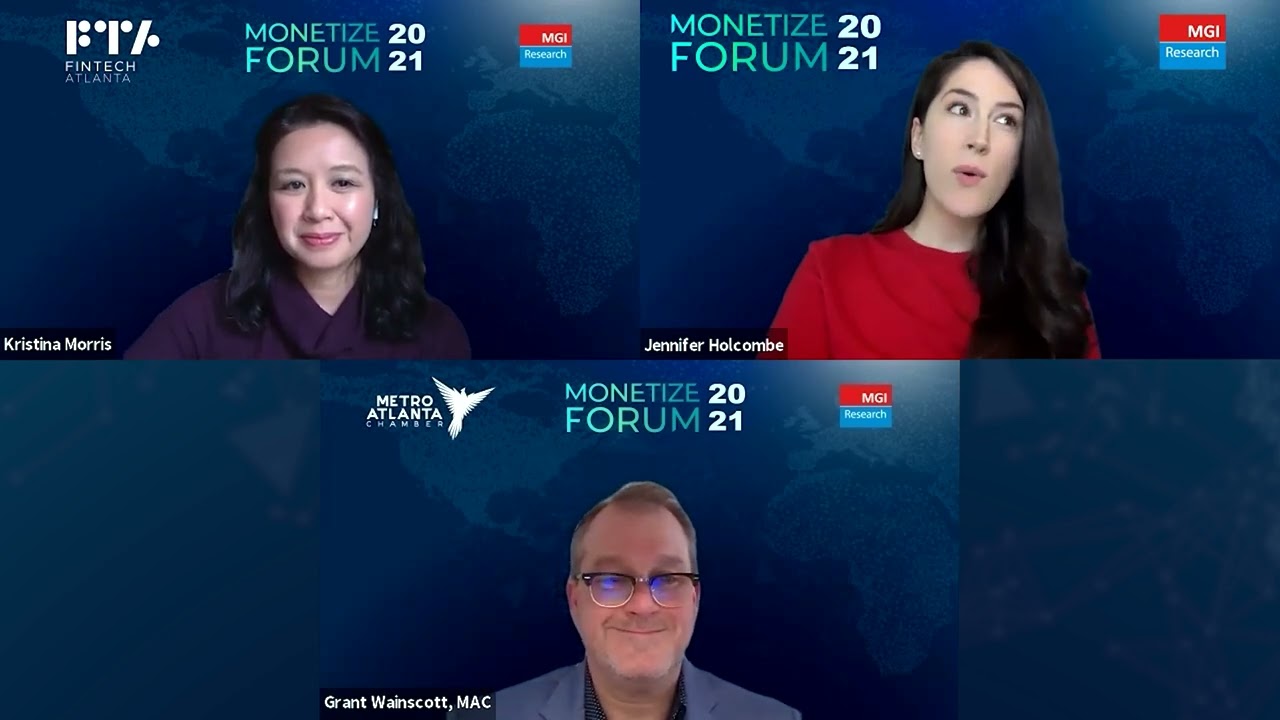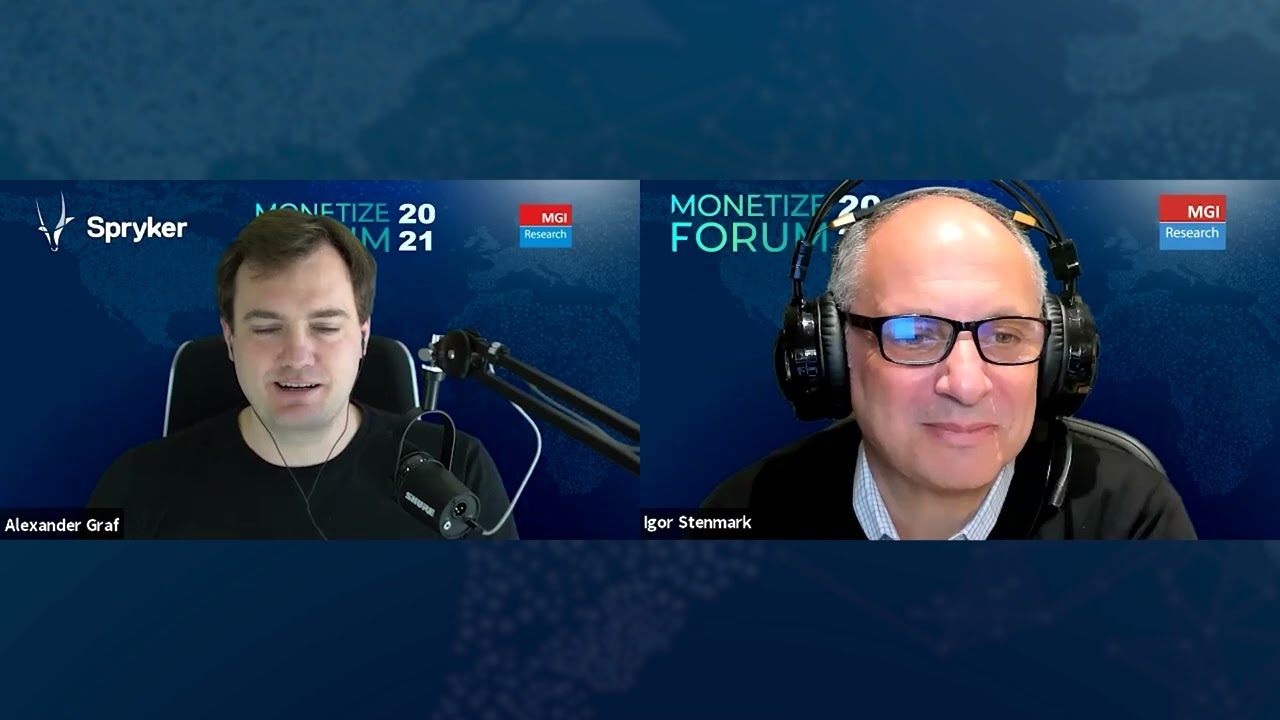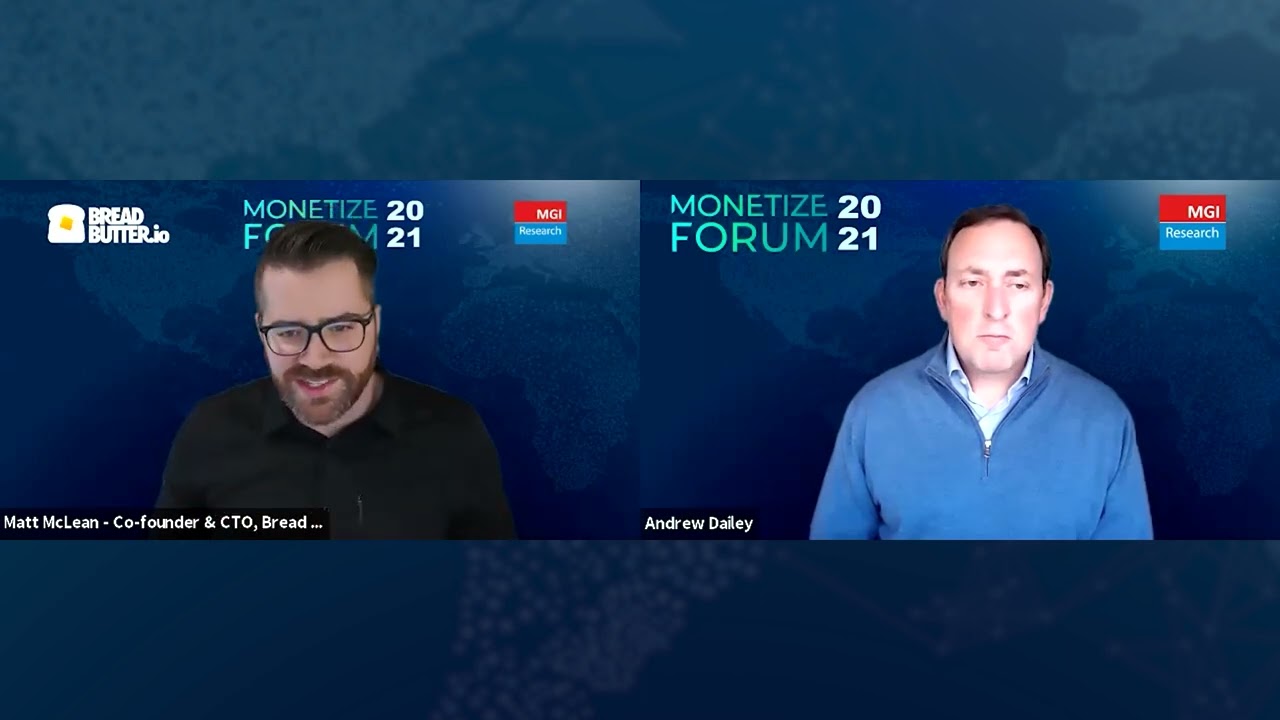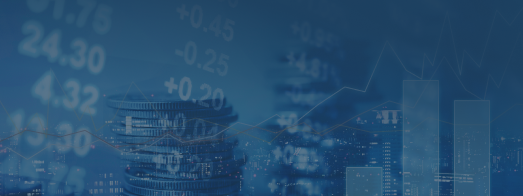
While the ongoing COVID-19 pandemic resulted in a boom in online retail, it threw deficiencies in both the marketplaces and other online channels into sharp relief. Even giants like Amazon struggled to keep up with their promises of speedy fulfillment. As a result, we saw emerging trends like brands turning to more direct-to-consumer channels and the rise of headless commerce gain momentum. To learn more about the e-business developments which came to fruition and those that we can expect in the coming years, we invited Michel da Silva to speak with MGI Research analyst Matthijs Koorn at the 2021 Monetize Forum. Michel holds the title of VP Sales eBusiness & Alliances at ModusLink, a company with over 50 years of experience dealing with the supply chain and a particular focus in the last 20 years on all things e-business.
Key Issues
How have marketplaces and direct channels been growing, and what can we expect in the future?
What kinds of challenges are involved in selling physical goods cross-border?
What developments in payments should companies look out for and be prepared to adopt?
Guest Profile
Michel serves as VP Global Sales eBusiness & Alliances at ModusLink, having previously held the posts of General Manager Business Unit eBusiness Director and Director Business Group. Before joining ModusLink, Michel held positions at companies including Adobe, Unic bv, TLLC bv, Mediasurface, Intershop Communications AG, Endeca, and GE Access.
Matthijs Koorn
Good afternoon. We’re here at the Monetize Forum, and I’m joined by Michel da Silva, VP of Sales eBusiness & Alliances at ModusLink. Michel, welcome.
Michel da Silva
Thank you, Matthijs. It’s nice to be here.
Matthijs Koorn
ModusLink is a bit of a known name in the markets, and you guys do some impressive things. Perhaps, though, it would be good to introduce the audience to ModusLink and tell us what you do.
Michel da Silva
ModusLink has existed for a long time already. It was established about 53 years ago, and the main focus has been on supply chain. However, for the last 20 years, the company has been really focusing on all the e-business-related topics like e-commerce, B2B fulfillment, payments, contact center, and order management. We had more and more customers that wanted to sell cross-border, so that’s why we developed all those services. ModusLink’s role now is to enable customers to focus on their own brands and sales by taking care of all the global fulfillment and local fiscal representation of compliance with taxes, et cetera.
Matthijs Koorn
Full-surface e-commerce…that’s great. What I’ve been doing in all my sessions is taking a look back at 2020. What takeaways from the year can you share with the viewers and listeners?
Michel da Silva
2020 was quite an extraordinary year, of course, with the pandemic. My takeaway is that you need to be prepared for these kinds of things. I don’t think this pandemic will be the last one, and there will be continued disruptions in the market, so you need to have everything properly structured with an execution plan to help customers if they want to change their strategy, their channels, et cetera. You need to be ready to facilitate that and to consult with them at that point.
Matthijs Koorn
That’s a good segue to the next question because one of the things we’re seeing is the changing roles of marketplaces and direct-to-consumer channels—how they’re evolving, specifically with brands. Is that something you’re seeing as well?
Michel da Silva
That’s an interesting question. About 12 years ago, I was part of an organization called the Ecommerce Foundation where we conducted market research and made predictions for the marketplaces, direct-to-consumer, and other channels. It was already clear 12 years ago that marketplaces would become a huge part of online sales—that wasn’t rocket science. However, what we’ve seen over the years is that they’re not good at sharing information. They keep most or all of their customer information, they dictate prices, and they also manufacture products that are then competing with the brands they’re selling in their marketplace. So that’s been an interesting evolvement in the last 12 years, though it’s actually quite natural if you look at what has happened over the last 30 years with grocery retailers. Large grocery retailers have also been pushing out their own brands because they can achieve a greater margin and bring in more money. What you see in the marketplaces over the last 12 years is the same development, so again, it’s not really rocket science.
However, the expectation was that direct-to-consumer channels would also grow significantly because you want to know how your customer acts and how they’re seeing and experiencing your product. If you look at the last 12 years though, they didn’t grow as significantly as marketplaces. There are all kinds of reasons for that. Let’s be honest—marketplaces are easier. Many brand manufacturers say, “I’ll send it to Amazon, eBay, or Rakuten. I can send pallets to them, and they’ll sell it.” It’s easy selling, but there are things like channel conflict, lack of knowledge, internal politics, and the question of selling products themselves online or not. 12 years ago, I would have expected that direct-to-consumer channels would grow as significantly as the marketplaces. They have grown, but not nearly at the same pace.
Now though, with the pandemic, companies and brands are forced to sell online, and we see huge growth which I think will continue going forward. Of course, brands that started 12 or more years ago are really seeing big results now, in addition to what they’re achieving in the marketplace. What do I see happening in the future? I think direct-to-consumer will continue to grow at a faster pace than before, but brands are also starting to act more and more as marketplaces themselves, so that’s going to be very interesting. Direct-to-consumer, marketplaces, and brands being their own marketplaces will be intertwined, and I think there’s still going to be a lot of growth in the next five years for all these channels.
Matthijs Koorn
That’s a very interesting observation. I get the impression there are also a lot of what I call “hidden marketplaces,” whereby a manufacturer on the back-end runs a marketplace where spare parts or parts for manufacturing are sold with each part coming from multiple suppliers. So, there’s competition on that end as well. Of course, we as consumers don’t always notice that, but there is a marketplace on the back-end.
Michel da Silva
Yes, absolutely.
Matthijs Koorn
You’re focused on physical goods. It’s very complex, particularly the cross-border aspect, which is what you’re focused on. What are some of the challenges? For instance, businesses were driven by the pandemic to all of a sudden sell physical goods online and even cross-border. What kinds of challenges are they now facing?
Michel da Silva
We focus on brands that are selling direct-to-consumer. Selling locally is already challenging sometimes, but as soon as you go cross-border, you have to deal with localization. For example, you’re dealing with other languages, even just language differences like those between British, Australian, and American English. Those languages look very similar, but there are differences there. You have to deal with time zones, customer behaviors, and different currencies as well. Then, you must focus on the digital marketing aspects. The most important part is the operational execution of selling a product and shipping it cross-border. Suddenly, you have to deal with taxes and where the product is stored. How is it delivered? Do you have a local presence or physical rep because it’s mandatory? There are long-distance selling mandates and regulations in a lot of countries which require you to be locally registered to deal with local tax authorities. There are local compliances like Vee which weighs electrical and electronic equipment. PCL (private copying levy) applies to products that can store information, and there are Intrastat reports for B2B sales. So, there are a lot of things you need to deal with.
Cross-border selling of physical products can be more complex than selling digital products. In some countries, there are different tax regulations when selling physical. There are so many elements there that you can get lost if you don’t pay attention. Then, there’s payments. You have to consider local payments because that has effects on your sales in your conversions. You want to have a solution to deal with compliancy, tax regulations, exemptions, and continued chains of governmental regulations. And if you have to deal with many countries, you want to have an experienced partner managing that, so you can focus on making your brand successful online with all the difficulties behind that out of your way.
Matthijs Koorn
Yes, you want to get rid of the headaches, so you can focus on your core business of selling the goods. Are there any specific countries or examples of where that’s especially difficult? Is there a case with many specific regulations like (as in your example) rules for products carrying information?
Michel da Silva
Yes, you need to know which country has which regulations, and even small countries can be a pain. For example, Switzerland is not a big country, and it’s a nice country to sell in, but it’s also a country where you have to deal with an export license and regulations on digital and fiscal. Digital products are taxed differently than fiscal products. There are exemptions, including that every product priced lower than 36 Swiss francs is free of tax while everything priced higher is taxed—unless, for example, you cross 180,000 Swiss francs in annualized sales on products priced under 36 Swiss francs; then, you need to start taxing. You can go crazy with one country alone. Just imagine what happens if you’re going to send your product to 30, 40, or 100 countries.
Matthijs Koorn
That’s a lot of local complexities to take care of.
Michel da Silva
Yes.
Matthijs Koorn
Another emerging trend, which you touched on a little bit in talking about channels, is the idea of headless commerce. Is that something you’re hearing about from clients as well?
Michel da Silva
Yes, I am hearing that from clients. I’ve been in e-commerce for 20 years, and this wish of selling anywhere, at any time, and with no technical constraints has already been present for many years. I remember that about 12 years ago, I had to deal with a large computer manufacturer that wanted to implement their concept of a physical store-in-store online with their distributors. At that time, without the technology we have now, dealing with the homemade CMS, the front-end content management system, was a nightmare. In fact, it was actually impossible, but it showed that there was already this wish of selling on sites beyond the corporate sites.
So now, with the available technology like content management systems which are easily integrated without the hassle and limitations of the past, selling anywhere at any time is becoming more and more of a reality, and e-commerce vendors are increasingly offering headless commerce. It makes sense with the markets that are in development now. For example, why shouldn’t it be possible to sell on an event platform? If you have an event like this online forum, why can’t you as a vendor create a small area on the website where you can promote and sell your products? The same possibility applies to kiosks and service sites. The flexibility to sell on any web content management or presentation layer is going to be the future.
Matthijs Koorn
True. I guess this is also made possible and accelerated by the general rise of microservices and APIs.
Michel da Silva
Yes, that’s correct.
Matthijs Koorn
Do you see a split between B2C and B2B, either in headless or in the effects of the pandemic? I think you do more B2B than B2C.
Michel da Silva
No, we actually do more B2C than B2B. We do more B2B fulfillment than B2C fulfillment, but on the e-commerce or e-business side, we do more B2C. We do have B2B customers, though, and it’s exactly the same in that they’re growing significantly. B2B is growing tremendously because they’re behind B2C. So, you see a lot of development going on there, yet those B2B customers want to sell on any presentation that they can get access to. I think that for the next couple of years, the growth and development will be parallel to each other.
Matthijs Koorn
I think B2B and B2C saw the same challenge during the pandemic. In many cases, their channels were closed, so they had to go direct, and I think B2B had been less online than B2C. So, it’s moving online, but there’s still a challenge.
Michel da Silva
Yes.
Matthijs Koorn
You touched on payments already, and that’s also an area which is innovating very rapidly. We see a lot of changes there. How important is it to keep up with those changes, and how much of a headache is that causing?
Michel da Silva
It’s very important because customer experience, customer expectation, and ease of use are very important. If you have a credit card or can pay with PayPal, Apple Pay, Google Pay, or any of the electronic wallets, that’s something which was just developed out of convenience. That will continue into options like paying in installments and credit limits, especially so people can buy the larger or more expensive products. That’s something you cannot stop. That convenience is growing more and more, even though there are some difficulties of local regulation. Of course, if you provide credit to end consumers, you need to have certain documents like PSD2 regulations, bank lines, et cetera. Still, you see many companies jumping in that area and getting the licenses, technology, and integrations. So, at a certain point, you will be able to integrate to a lot of companies that offer those services for the convenience of your consumer being able to buy via their preferred method. That will raise conversion and increase sales.
Matthijs Koorn
Yes, but that’s another headache if you’re going online. Then, looking at it per country again adds a lot of complexities and, as you rightly pointed out, variance in regulations. It’s very difficult. You mentioned installment payments and buy now/pay later. Is that something you see on the B2B side as well as more of a working capital type of financing?
Michel da Silva
Yes, absolutely. Normally they would go to a bank to get that resolved. Now you see more and more of what I call “web banks” that have the technology to offer that specific solution to a B2B customer.
Matthijs Koorn
Interesting. Again, that’s also part of driving conversion. I think all of this would be impossible without partnerships. How important are partners for ModusLink?
Michel da Silva
They’re extremely important. If we want to deliver all these services, we need partners on the technology side. We partner very closely with e-commerce platforms, and we’re currently expanding our list of big commerce partners like Shopify. Those are the partnerships that have the technology, and that’s how we integrate. We do implement some of them if it’s not complex, but it’s really just partnerships in that area. It’s the same with the technology behind it. As you already mentioned, for install payments and very localized solutions, there are so many outside technology providers. You need to partner for that as well because all the investment you would need to do in order to handle it yourself just isn’t possible. We also see a lot of partnerships with companies like systems integrators which aren’t familiar with the complex technology outside of their field. For example, we work with Accenture on some of those elements. They come across so many complex topics selling cross-border that they’re partnering with companies like us.
Matthijs Koorn
Yes, that’s probably not a day-to-day activity for them, so it’s the same value proposition: outsource the complexity.
Michel da Silva
Correct, yes.
Matthijs Koorn
Michel, it’s been great catching up. I’m afraid our time has run out, but I’m sure you’re around if people have questions.
Michel da Silva
Absolutely.
Matthijs Koorn
Excellent. Thank you very much.
Michel da Silva
Thank you.




